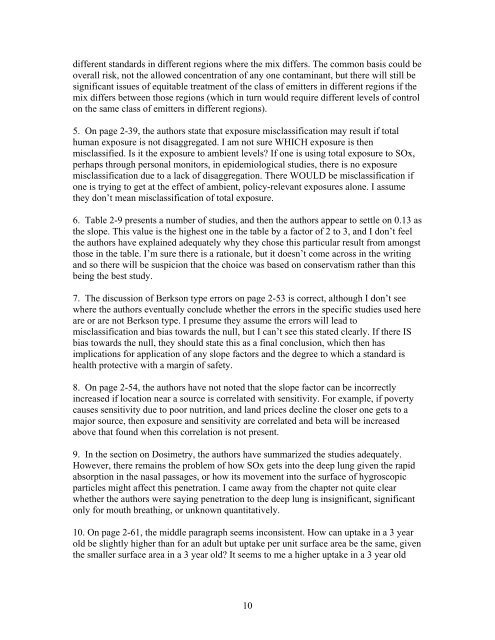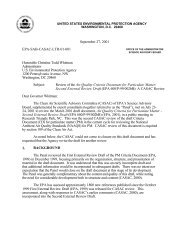(CASAC) Peer Review of EPA's Integrated Science Assessment
(CASAC) Peer Review of EPA's Integrated Science Assessment
(CASAC) Peer Review of EPA's Integrated Science Assessment
Create successful ePaper yourself
Turn your PDF publications into a flip-book with our unique Google optimized e-Paper software.
different standards in different regions where the mix differs. The common basis could beoverall risk, not the allowed concentration <strong>of</strong> any one contaminant, but there will still besignificant issues <strong>of</strong> equitable treatment <strong>of</strong> the class <strong>of</strong> emitters in different regions if themix differs between those regions (which in turn would require different levels <strong>of</strong> controlon the same class <strong>of</strong> emitters in different regions).5. On page 2-39, the authors state that exposure misclassification may result if totalhuman exposure is not disaggregated. I am not sure WHICH exposure is thenmisclassified. Is it the exposure to ambient levels? If one is using total exposure to SOx,perhaps through personal monitors, in epidemiological studies, there is no exposuremisclassification due to a lack <strong>of</strong> disaggregation. There WOULD be misclassification ifone is trying to get at the effect <strong>of</strong> ambient, policy-relevant exposures alone. I assumethey don’t mean misclassification <strong>of</strong> total exposure.6. Table 2-9 presents a number <strong>of</strong> studies, and then the authors appear to settle on 0.13 asthe slope. This value is the highest one in the table by a factor <strong>of</strong> 2 to 3, and I don’t feelthe authors have explained adequately why they chose this particular result from amongstthose in the table. I’m sure there is a rationale, but it doesn’t come across in the writingand so there will be suspicion that the choice was based on conservatism rather than thisbeing the best study.7. The discussion <strong>of</strong> Berkson type errors on page 2-53 is correct, although I don’t seewhere the authors eventually conclude whether the errors in the specific studies used hereare or are not Berkson type. I presume they assume the errors will lead tomisclassification and bias towards the null, but I can’t see this stated clearly. If there ISbias towards the null, they should state this as a final conclusion, which then hasimplications for application <strong>of</strong> any slope factors and the degree to which a standard ishealth protective with a margin <strong>of</strong> safety.8. On page 2-54, the authors have not noted that the slope factor can be incorrectlyincreased if location near a source is correlated with sensitivity. For example, if povertycauses sensitivity due to poor nutrition, and land prices decline the closer one gets to amajor source, then exposure and sensitivity are correlated and beta will be increasedabove that found when this correlation is not present.9. In the section on Dosimetry, the authors have summarized the studies adequately.However, there remains the problem <strong>of</strong> how SOx gets into the deep lung given the rapidabsorption in the nasal passages, or how its movement into the surface <strong>of</strong> hygroscopicparticles might affect this penetration. I came away from the chapter not quite clearwhether the authors were saying penetration to the deep lung is insignificant, significantonly for mouth breathing, or unknown quantitatively.10. On page 2-61, the middle paragraph seems inconsistent. How can uptake in a 3 yearold be slightly higher than for an adult but uptake per unit surface area be the same, giventhe smaller surface area in a 3 year old? It seems to me a higher uptake in a 3 year old10
















